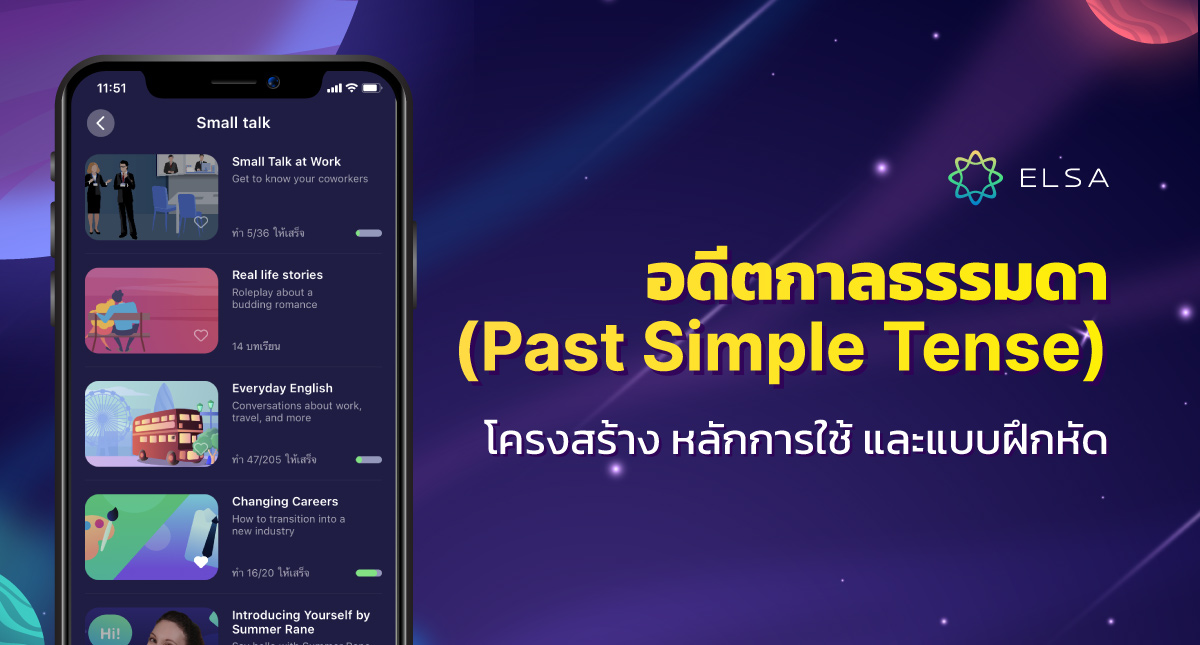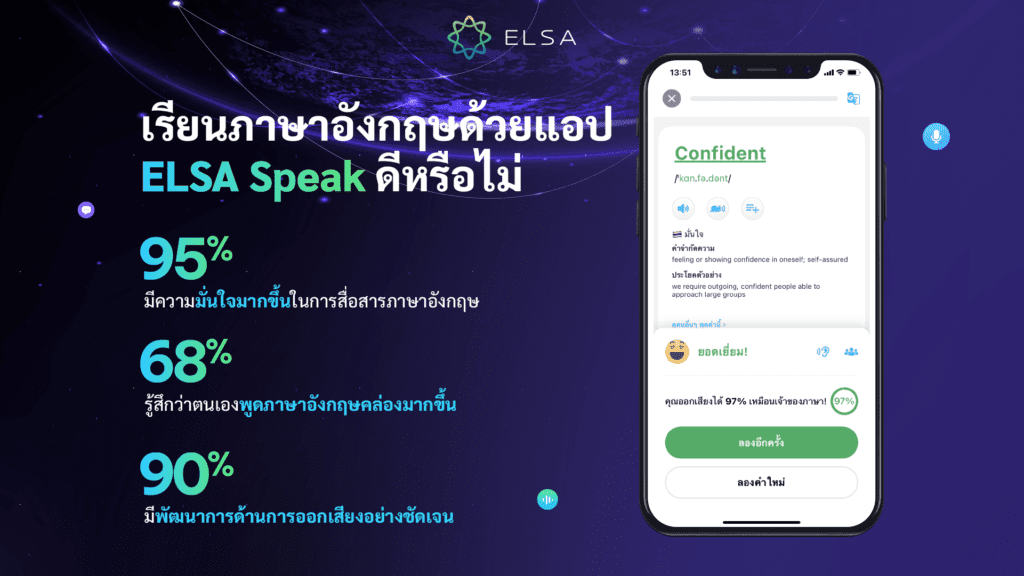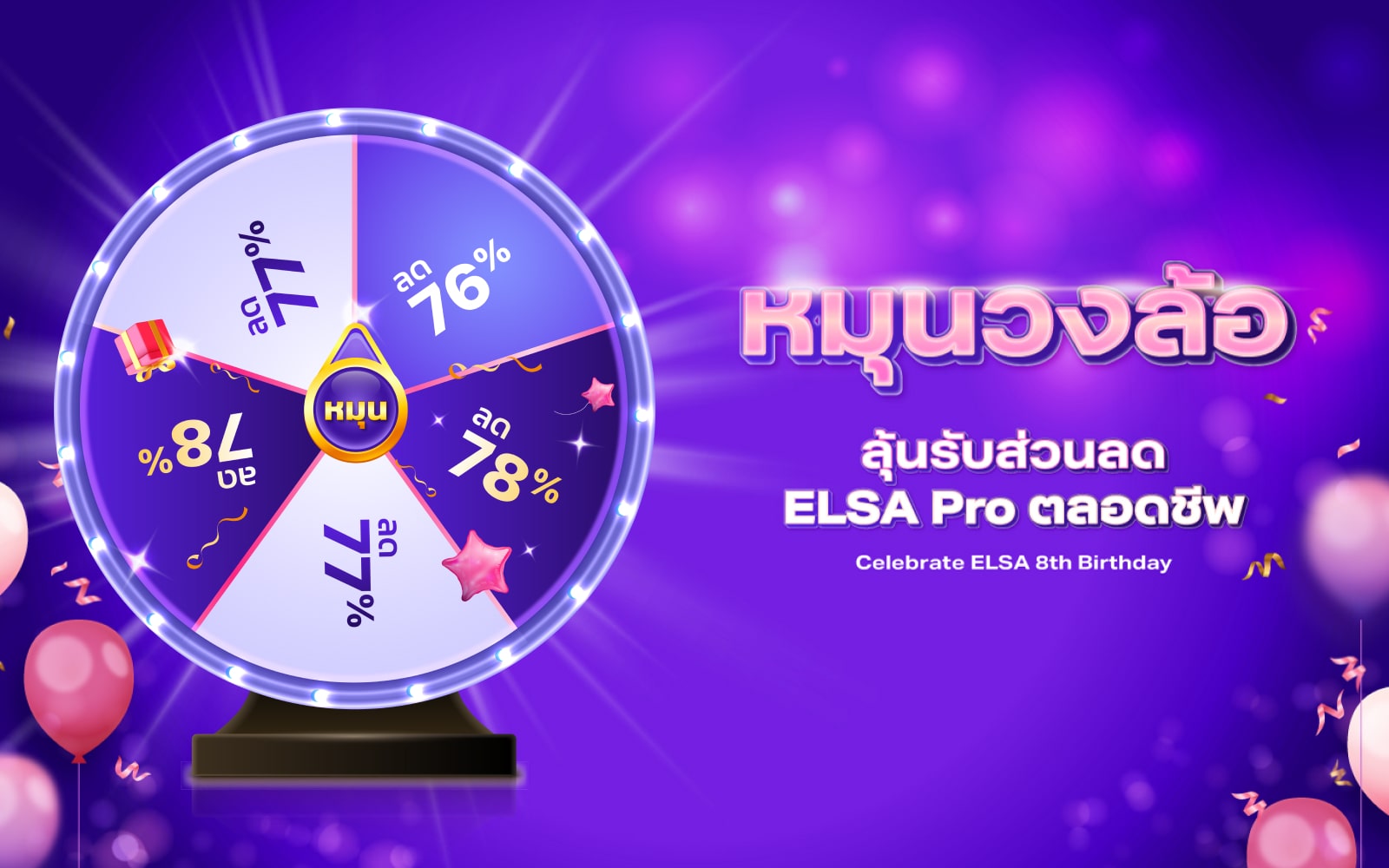กาลอดีตกาลธรรมดา (Past Simple Tense) เท่ากับ 12 Tense ต่าง ๆ มากมายในภาษาอังกฤษเข้ามาเป็นหัวข้อที่สำคัญสำหรับเรียนภาษาอังกฤษทุกคนมาร่วมกันELSA พูดเพื่อสรุปความรู้ทั้งหมดเกี่ยวกับการใช้, วิธีใช้, และสัญญาณของกาลอดีตกาลธรรมดาๆ มาดูด้วยข้อดีที่มีเฉลยกันเถอะ!
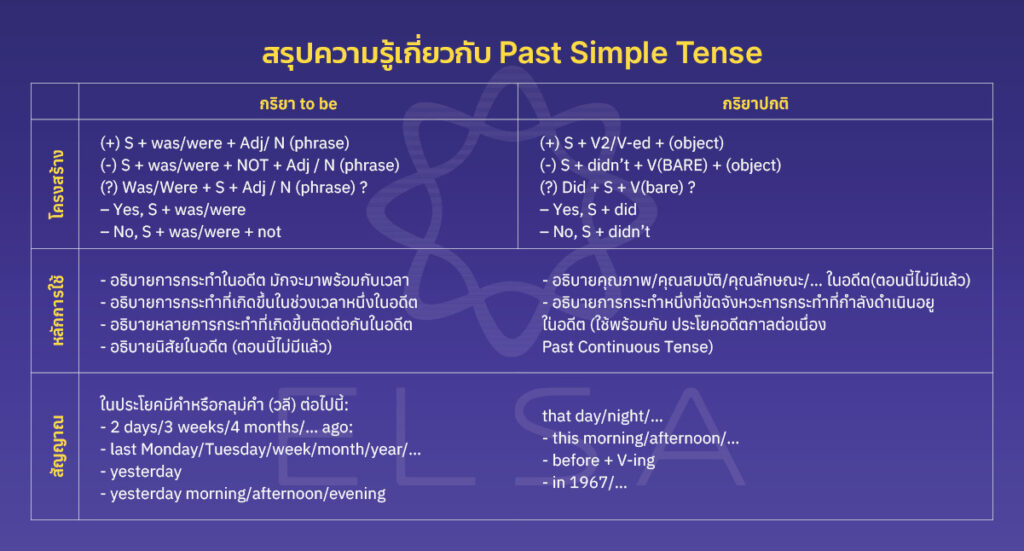
Past Simple Tense คืออะไร
กาลอดีตกาลธรรมดาในภาษาอังกฤษ (Past Simple หรือ Simple Past) เป็นกาลที่ใช้เพื่อบอกเล่า เหตุการณ์หรือการกระทำที่เกิดขึ้นแล้วในอดีต นอกจากนี้ ยังใช้เพื่อบรรยาย เหตุการณ์หรือการกระทำที่เพิ่งจะสิ้นสุดลงในอดีต อีกด้วย
สอบก่อนเข้าฟรี

Past Simple Tense ตัวอย่างประโยค:
- When I was young, I usually went to school late.
- We didn’t attend the meeting yesterday.
- Two days ago, they were sick.
- My grandparents bought this house many years ago.
Past Simple Tense โครงสร้าง
Past Simple Tense โครงสร้างในรูปแบบต่างๆ
| กริยา to be | กริยาปกติ | |
|---|---|---|
| ประโยคบอกเล่า | S + was/were + Adj/ N (phrase) | S + V2/V-ed + (object) |
| ประโยคปฏิเสธ | S + was/were + NOT + Adj / N (phrase) | S + didn’t + V(BARE) + (object) |
| ประโยคคำถาม | Was/Were + S + Adj / N (phrase) ? – Yes, S + was/were – No, S + was/were + not | S + was/were + Adj/ N (phrase) |
Past Simple Tense โครงสร้างประโยคบอกเล่า
| กริยา to be | กริยาปกติ | |
|---|---|---|
| โครงสร้าง | S + was/were + Adj/ N (phrase) | S + V2/V-ed + (object) |
| ตัวอย่าง | At 5pm yesterday, that customer was at our company. When that customer came this afternoon, we were out for lunch. | We lived in Bangkok for 5 years before moving to Chiang Mai. Yesterday, my mom caught some rats in the kitchen. |
ตารางประธาน (Subject) กับคำกริยาไปด้วยกัน:
| Subject | Verb to be |
|---|---|
| I/He/She/It/Mybrother/The cat/… | was |
| We/You/They/My parents/Our teachers/… | were |
*หมายเหตุ คำกริยาปกติ:
V2 เป็นกริยาช่องที่ 2 ที่ผันมาจากกริยาช่องที่ 1 ของคำกริยาอปกติ (ไม่เป็นไปตามกฎเพิ่ม -ed)
ตัวอย่าง: catch – caught – caught, begin- began– begun, v.v.
V-ed เป็นกริยาช่องที่ 2 ของกริยาปกติ (เป็นไปตามกฎเพิ่ม -ed ที่ช่อง 2 และช่อง 3 ของคำกริยา)
ตัวอย่าง: want- wanted– wanted, watch- watched– watched, v.v.
ศึกษาตารางคำกริยาไม่เป็นไปตามกฎ (Irregular Verbs) ในช่องที่ 2 ซึ่งมักพบบ่อย
โครงสร้างประโยคปฏิเสธ Past Simple Tense
| กริยา to be | กริยาปกติ | |
|---|---|---|
| โครงสร้าง | S + was/were + NOT + Adj / N (phrase) | S + didn’t + V(BARE) + (object) |
| ตัวอย่าง | She wasn’t at home when you called this morning. Those college students were not studious during their first year. | Those employees didn’t go on the company trip. I tried to call that customer, but she didn’t pick up. |
*หมายเหตุ:
- was not= wasn’t
- were not= weren’t
- did not = didn’t
โครงสร้างประโยคคำถาม Past Simple Tense
คำถาม Yes-No
| กริยา to be | กริยาปกติ | |
|---|---|---|
| โครงสร้าง | Was/Were + S + Adj / N (phrase) ? | Did + S + V(bare) ? |
| คำตอบ | Yes, S + was/were No, S + was/were + not | Yes, S + did No, S + didn’t |
| ตัวอย่าง | Were you at Jack’s party last night? → Yes, I was. | Did you come across your high school friend this morning? → Yes, I did. I was so happy to see her again |

คำถาม Wh-
คำกริยา Be
| กลุ่มที่ 1: When/Where/Why/What/How + was/were (not) + S + Adj / N (phrase) + …? |
| กลุ่มที่ 2: Who/What + was/were (not) + Adj / N (phrase)/… + …? (คำถามเป็น S: ประธาน) |
Simple Past Tense ตัวอย่างประโยค:
- Where were your brother last night? (พี่ชาย/น้องชายของคุณอยู่ที่ไหนเมื่อคืนนี้?)
- What were your hobbies when you were a kid? (งานอดิเรกของคุณตอนเด็กๆ คืออะไร?)
- Why weren’t you by my side when I needed you the most? (ทำไมคุณไม่อยู่เคียงข้างฉันเมื่อฉันต้องการคุณมากที่สุด)
- Who were in the meeting room 2 hours ago? (ใครอยู่ในห้องประชุมเมื่อ 2 ชั่วโมงที่แล้ว?)
คำกริยาที่บอกการกระทำ (Action Verbs)
| กลุ่มที่ 1: When/Where/Why/What/How + did (not) + S + V(BARE) + (object) + …? |
| กลุ่มที่ 2: Who/What + V2/V-ed + (object) + …?Who/What + didn’t + V(BARE) + (object) + …?(คำถามเป็น S: ประธาน) |
Simple Past Tense ตัวอย่างประโยค:
- Who washed the dishes this afternoon? (ใครล้างจานเมื่อบ่ายนี้?)
- Where did your family go last weekend? (วันหยุดสุดสัปดาห์ที่แล้วครอบครัวของคุณไปที่ไหน?)
- Who didn’t take part in the activity? (ใครไม่ได้ร่วมกิจกรรม)
- What caused that tragic accident? (อะไรทำให้เกิดภัยพิบัติครั้งนั้น?
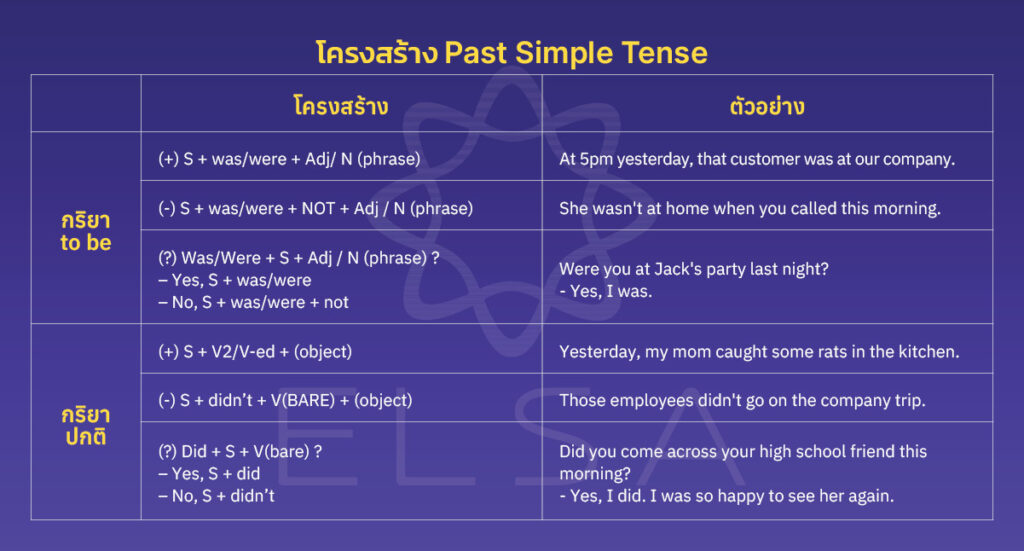
หลักการใช้ Past Simple Tense
อดีตกาลธรรมดามีการใช้งานหลักดังต่อไปนี้:
อธิบายการกระทำในอดีต มักจะมาพร้อมกับเวลา
They established this company in 1998 (พวกเขาก่อตั้งบริษัทนี้ในปี 1988)
Last night, my friend and I didn’t go to the cinema (เมื่อคืนฉันกับเพื่อนไม่ได้ไปโรงหนัง)
อธิบายการกระทำที่เกิดขึ้นในช่วงเวลาหนึ่งในอดีต
My family lived in Bangkok for 4 years (ครอบครัวของฉันเคยอาศัยอยู่ที่กรุงเทพเป็นเวลา 4 ปี)
Our son didn’t study there for a year, just a few months (ลูกเราไม่ได้เรียนที่นั่น 1 ปี แค่ไม่กี่เดือนเอง)
อธิบายหลายการกระทำที่เกิดขึ้นติดต่อกันในอดีต
She parked her car, got out, put on her hat and walked towards the building. (เธอจอดรถ ออกไป สวมหมวก แล้วเดินไปที่ตึก)
อธิบายนิสัยในอดีต (ตอนนี้ไม่มีแล้ว)
When my younger sister was in high school, she went swimming every day. (ตอนที่น้องสาวของฉันเรียนมัธยมปลาย เธอเคยไปว่ายน้ำทุกวัน)
I didn’t drink enough water or eat vegetables when I was a teenager. (ฉันดื่มน้ำหรือกินผักไม่พอเมื่อฉันยังเป็นวัยรุ่น)
5. อธิบายคุณภาพ/คุณสมบัติ/คุณลักษณะ/… ในอดีต (ตอนนี้ไม่มีแล้ว)
Her younger brother was very naughty that day. (น้องชายของเธอเกเรมากในวันนั้น)
Last summer, it was very sunny and hot. (ฤดูร้อนที่แล้วมีแดดจัดและร้อนจัด)
6. อธิบายการกระทำหนึ่งที่ขัดจังหวะการกระทำที่กำลังดำเนินอยู่ในอดีต (ใช้พร้อมกับ ประโยคอดีตกาลต่อเนื่อง Past Continuous Tense)
This morning, I was discussing with my team when you called. (เมื่อเช้านี้ ฉันกำลังคุยกับทีมของฉันเมื่อคุณโทรมา)
This morning, you called while I was discussing with my team. (เมื่อเช้านี้ คุณโทรมาขณะที่ฉันกำลังคุยกับกลุ่มของฉัน)
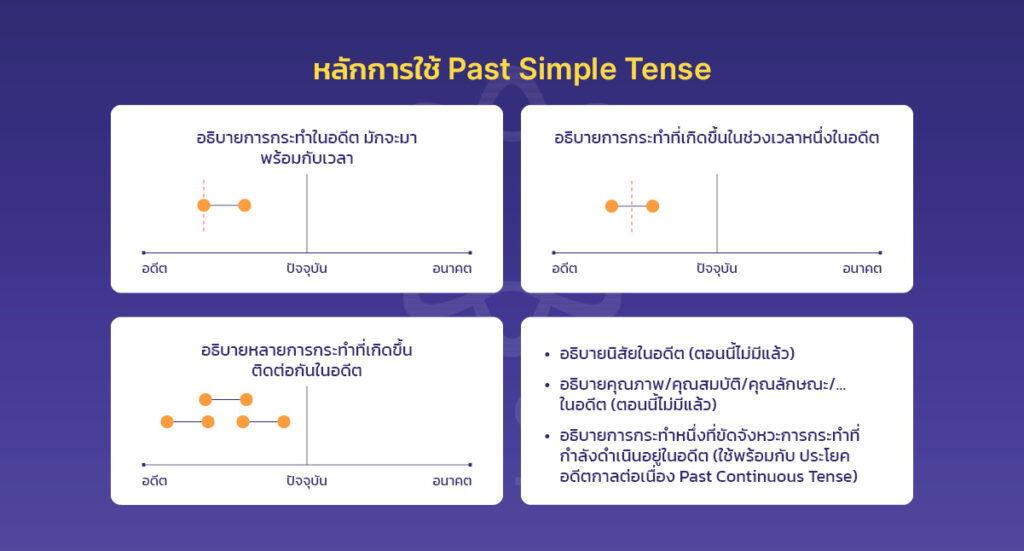
สัญญาณเพื่อรับรู้ Past Simple Tense
ประโยคใช้โครงสร้างหนึ่งอยู่ในโครงสร้างของข้อ 2 และมีเครื่องหมายที่สำคัญที่สุดคือกริยาในรูปแบบ V2 หรือ V-ed
ในประโยคมีคำหรือกลุ่มคำ (วลี) หรือ clause ต่อไปนี้:
ก. วลี
- 2 days/3 weeks/4 months/… ago:: 2 วัน/3 สัปดาห์/4 เดือน/… ที่แล้ว
- last Monday/Tuesday/week/month/year/…: วันจันทร์/วันอังคาร/สัปดาห์/เดือน/ปี/… ที่ผ่านมา
- yesterday: เมื่อวาน
- yesterday morning/afternoon/evening: เช้า/บ่าย/คืนของเมื่อวาน
- that day/night/…: วัน/คืน/… นั่น
- this morning/afternoon/…: เช้า/บ่าย/…วันนี้
- before + V-ing: ก่อน…
- in 1967/…: ในปี 1967/…
ข. Clause
- when I was young: เมื่อฉันยังเด็ก
- when I was a child: เมื่อฉันยังเป็นเด็ก
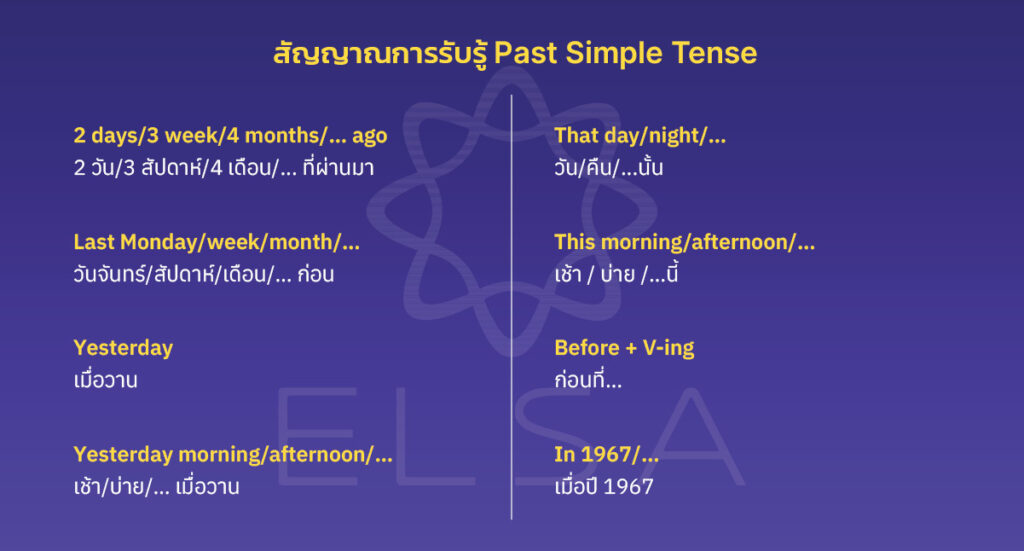
กฎบางอย่างเกี่ยวกับคำกริยาใน Past Simple Tense
ตามที่ระบุไว้โดยสังเขปในส่วนโครงสร้าง ใน Simple Past Tense กริยาปกติสามารถมีรูปแบบใดรูปแบบหนึ่งจากสองรูปแบบ ได้แก่ V-ed (กริยาปกติ) และ V2 (กริยาอปกติ หรือ irregular verbs) เพื่อทำความเข้าใจเพิ่มเติมเกี่ยวกับรูปแบบคำกริยา 2 รูปแบบนี้และวิธีใช้ ให้อ่านต่อ 2 บทความด้านล่าง:
- วิธีออกเสียง ed ในภาษาอังกฤษที่ง่ายและจำง่ายที่สุด
- ตารางคำกริยาอปกติภาษาอังกฤษที่สมบูรณ์และแม่นยำที่สุด
| awake | awoke | awoken | ตื่น/ปลุกคนให้ตื่น |
| backslide | backslid | backslid backslidden | กลับไปเป็นเหมือนเดิม |
| be | was/were | been | เป็น/คือ |
| bear | bore | born | อดทน / พกบางสิ่ง / ให้กำเนิด |
| beat | beat | beat beaten | ตี/โดน |
| become | became | become | กลายเป็น |
| befall | befell | befallen | (อะไร) เกิดขึ้น |
| begin | began | begun | เริ่ม |
| behold | beheld | beheld | ดู |
ตัวอย่างประโยค past simple tense 20 ประโยค
- She studied hard for the exam. (เธอเรียนหนักเพื่อการสอบ)
- They played football in the park last Saturday. (พวกเขาเล่นฟุตบอลที่สวนสาธารณะเมื่อวันเสาร์ที่ผ่านมา)
- We watched a movie last night. (พวกเราดูหนังเมื่อคืนที่ผ่านมา)
- He finished his homework an hour ago. (เขาทำการบ้านเสร็จเมื่อหนึ่งชั่วโมงที่แล้ว)
- I bought a new book last week. (ฉันซื้อหนังสือเล่มใหม่เมื่อสัปดาห์ที่แล้ว)
- She called me this morning. (เธอโทรหาฉันเมื่อเช้านี้)
- They went to the beach during the holiday. (พวกเขาไปชายหาดในช่วงวันหยุด)
- I saw him at the party yesterday. (ฉันเห็นเขาที่งานปาร์ตี้เมื่อวานนี้)
- We traveled to Paris last summer. (พวกเราเดินทางไปปารีสเมื่อฤดูร้อนที่แล้ว)
- He worked at the company for 10 years. (เขาทำงานที่บริษัทเป็นเวลา 10 ปี)
- She danced all night at the concert. (เธอเต้นทั้งคืนที่คอนเสิร์ต)
- He woke up, took a shower, and had breakfast. (เขาตื่นนอน อาบน้ำ และทานอาหารเช้า)
- I ate pizza for lunch yesterday. (ฉันกินพิซซ่ามื้อเที่ยงเมื่อวานนี้)
- We visited the museum last month. (พวกเราไปเยี่ยมพิพิธภัณฑ์เมื่อเดือนที่แล้ว)
- He played video games for two hours. (เขาเล่นเกมคอมพิวเตอร์เป็นเวลา 2 ชั่วโมง)
- She wrote a letter to her friend. (เธอเขียนจดหมายถึงเพื่อนของเธอ)
- I cleaned my room yesterday. (ฉันทำความสะอาดห้องเมื่อวานนี้)
- They listened to music all day. (พวกเขาฟังเพลงทั้งวัน)
- We arrived late to the meeting. (พวกเรามาถึงที่การประชุมช้า)
- I visited my grandmother yesterday. (ฉันไปเยี่ยมคุณยายเมื่อวานนี้)
แยกแยะ Past Simple Tense กับ Tense อื่นๆ
แยกแยะ Past Simple Tense และ Past Continuous Tense
| Past Simple Tense | Past Continuous Tense |
| โครงสร้างประกอบด้วย: V2/ed | โครงสร้างประกอบด้วย: was/were (not) + V-ing |
| ไม่พูดเกี่ยวกับการกระทำที่เกิดขึ้นในขณะที่พูดหรือช่วงเวลาที่พูด | หน้าที่หลักคือการอธิบายเหตุการณ์/การกระทำที่เกิดขึ้นในช่วงเวลาหนึ่งในอดีต ตัวอย่างเช่น I was discussing with my team at 10 this morning → ฉันกำลังคุยกับกลุ่มของฉันตอน 10 โมงเช้าวันนี้ |
เข้าใจและใช้ Past Tense ได้อย่างถูกต้องและเป็นธรรมชาติ
ประโยคอดีตกาลต่อเนื่อง (Past Continuous Tense): โครงสร้างและแบบฝึกหัด
วิธีใช้ Past Perfect Tense (กาลอดีตก่อนหน้า) ที่เข้าใจง่ายที่สุด
2. แยกแยะ Past Simple Tense และ Present Perfect Tense
| Past Simple Tense | Present Perfect Tense |
| ใช้โครงสร้างในส่วนที่ 2 | โครงสร้างประกอบด้วย: has/have + V3/V-ed |
| มีฟังก์ชันเดียวกันกับ Present Perfect Tense: แสดงเหตุการณ์ที่เกิดขึ้นในอดีต – ข้อแตกต่างคือ Past Simple Tense มักจะมาพร้อมกับเวลาที่เกิดขึ้นของเหตุการณ์ เช่น My aunt bought a new car last week → ป้าของฉันซื้อรถใหม่เมื่อสัปดาห์ที่แล้ว | มีฟังก์ชันเดียวกันกับ Past Simple Tense คือแสดงเหตุการณ์ที่เกิดขึ้นในอดีต – ข้อแตกต่างคือ Present Perfect tense ไม่ได้มาพร้อมเวลาที่เหตุการณ์เกิดขึ้นเนื่องจากผู้พูดไม่ทราบ หรือไม่อยากบอก เช่น My aunt has bought a new car → ป้าของฉันซื้อรถใหม่ |
เข้าใจแนวทางการใช้กาลต่างๆในภาษาอังกฤษอย่างมั่นคง:
- ประโยคอนาคตกาล ( Future Simple Tense ): โครงสร้างและแบบฝึกหัด
- Present Continuous Tense: โครงสร้าง หลักการใช้งาน
- ประโยคปัจจุบันกาล (Present Simple Tense): โครงสร้าง การใช้งาน
- อนาคตกาลสมบูรณ์ต่อเนื่อง (Future Perfect Continuous Tense)
- Future Continuous Tense: โครงสร้างและหลักการใช้งาน
- Present Perfect Continuous Tense โครงสร้าง ตัวอย่าง และแบบฝึกหัดพร้อมคำตอบ
แบบฝึกหัด Past Simple Tense
1. แบบฝึกหัด
ผันคำกริยาใน (…):
1. He ………… (wake) up, ………… (check) his phone, ………… (get) out of bed, ………… (drink) some water and ………… (rush) to the bathroom.
2. He ………… (spend) 4 years in that beautiful city. He ………… (no do) much there.
3. Last week, you ………… (go) to work late 4 times.
4. Yesterday, ………… (not meet) the deadline, so our boss ………… (be) very upset.
5. I ………… (enjoy) watching TV when I was a kid. Now, I prefer Netflix.
6. Yesterday evening, I was walking home when I ………… (see) a tragic accident.
7. They ………… (sign) their first contract in 2006.
ตั้งคำถามสำหรับส่วนที่ขีดเส้นใต้:
1. Peter prepared all of the documents last week.
2. My family didn’t go camping last week because it rained all day.
3. This morning, I woke my son up by playing some rock songs.
4. Two days ago, he gave some money to a stranger.
5. That employee started working for our company in 2016.
6. Yesterday, we hid our memory box in the garden.
7. They first met each other 17 years ago.
2. คำตอบสำหรับแบบฝึกหัด Past Simple Tense
ผันคำกริยาใน (…)
1. woke – cheked – got – drank – rushed
2. spent – didn’t do
3. went
4. didn’t meet – was
5. enjoyed
6. saw
7. signed
ตั้งคำถามสำหรับส่วนที่ขีดเส้นใต้:
1. Who prepared all of the documents last week?
2. Why didn’t your family go camping last week?
3. How did you wake your son up this morning?
4. Whom did he give money to two days ago?
5. When did that employee start working for our company?
6. Where did you hide your memory box yesterday?
7. When did they first meet each other?
เช่นนั้นเราได้เรียนรู้ความรู้ที่จำเป็นทั้งหมดเกี่ยวกับอดีตกาลธรรมดา แล้ว ELSA Speak หวังว่าหลังจากอ่านบทความนี้ คุณจะสามารถใช้ Past Simple Tense ได้อย่างคล่องแคล่วและเป็นมืออาชีพเวลาสื่อสารภาษาอังกฤษ หวังว่าคุณจะเรียนรู้ได้ดี!
โครงสร้าง Past Simple Tense และ Past Continuous Tense มักจะใช้ร่วมกันในกรณีที่เกิดสถานการณ์ไม่คาดฝันขึ้น เข้าร่วม ELSA Speak เรียนรู้บทความ การผสมผสานระหว่าง Past Simple Tense และ Past Continuous Tense เพื่อให้สามารถใช้โครงสร้างนี้ได้อย่างคล่องแคล่วยิ่งขึ้นนะ
เยี่ยมชมเว็บไซต์ th.elsaspeak.com เป็นประจำเพื่อรับความรู้เพิ่มเติมเกี่ยวกับการศึกษาการสื่อสารภาษาอังกฤษด้วยตนเองสำหรับคนวัยทำงานและวัยเรียน!
